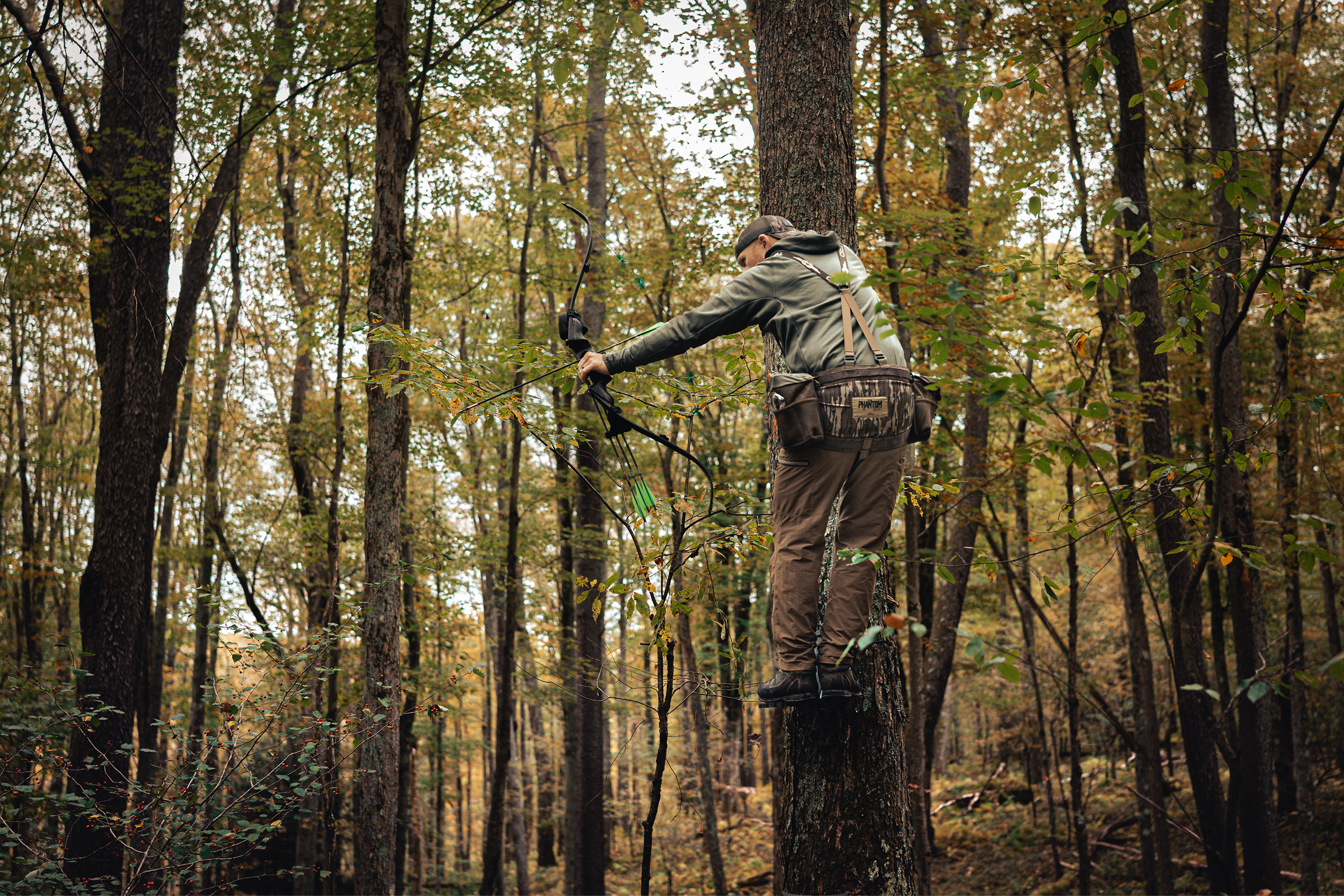what is saddle hunting?
Saddle hunting is an efficient and lightweight way to get into a tree using just a harness and a rope system that keeps you safely connected the entire time. You are not limited to perfect trees either, you can hunt from just about anything, including crooked, branchy, or gnarly trees, all while staying comfortable and secure for long sits. There is a bit of a learning curve, but it is easier than you might think. After a few tries, you will wonder why you ever lugged around a metal tree stand. It is lighter, safer, and a whole lot more enjoyable.
BENEFITS OF SADDLE HUNTING
Tree Versatility
Hunt where the deer are not where your treestand is.
Lightweight
Saddles are significantly lighter than tree stands.
360° Shooting
Rotate around the tree for nearly every shot angle.
Stay Hidden
Hide behind the tree.
how to saddle hunt
 ►
►
Why Tethrd
We love saddle hunters, because we are saddle hunters.
 ►
►
What is Saddle Hunting
An introduction to the concept of saddle hunting and its effectiveness.
 ►
►
Comfort
Tips for all-day comfort in your saddle setup.
 ►
►
Safety
Best practices to ensure safety while climbing and hunting.
 ►
►
How Do I Shoot?
Learn different shooting positions and how to stay stable in the saddle.
 ►
►
What About My Feet?
Understand foot platform and ring of steps options for maneuverability.
 ►
►
How Do I Climb?
A guide to climbing methods for saddle hunting beginners.
 ►
►
How Do I Setup In The Tree
Step-by-step process of selecting and preparing your hunting tree.
 ►
►
How to Saddle Hunt: A Beginner's Guide
Everything you need to know to get started with saddle hunting.
 ►
►
Saddle Hunting Techniques
More advanced techniques and positioning while in the saddle.
 ►
►
How to Saddle Hunt
A clear walkthrough on how saddle hunting works from the ground up.
 ►
►
Saddle Hunting Ropes
Learn about the ropes you’ll need and how to use them safely in the tree.
 ►
►
Climbing Sticks
An overview of climbing stick options and how to use them effectively.
 ►
►
Platforms
Learn how to use your platform to make you more mobile.
 ►
►
Shot Execution
Tips for stable and accurate shots while hunting from a saddle.
 ►
►
Advanced Setup
Fine-tune your gear and techniques for the most efficient saddle setup.
 ►
►
Tethering Techniques
Best practices and adjustments for using your tether more efficiently.
NOT SURE WHERE TO START?
SADDLE HUNTING ESSENTIALS
There are 4 critical components to saddle hunting: Ropes, Saddle, Climbing Sticks, and a Platform. We also have Complete Starter Kits which include everything you need to get started.
1. Pick Your Ropes
The Lineman Belt safely connects you to the tree while you climb, and the Tree Tether connects you at your platform.
Shop Ropes2. Pick Your Saddle
From ultra-light (Phantom) to ultra-comfort (Ultralock), Tethrd saddles are safe, versatile, and built for all-day use.
Shop Saddles3. Pick Your Sticks
The Skeletors are rugged and budget-friendly. The One Stick is the lightest climbing stick available at just 1 lb.
Shop Sticks4. Pick Your Platform
The Predator V is the best all-around platform. For lighter needs, the Predator CFX weighs just 2.3 lbs.
Shop Platformssaddle hunting instructions
 ►
►
Ultralock SD
Learn how to install and use the Ultralock SD system.
 ►
►
Ultralock
Overview of the standard Ultralock design and setup.
 ►
►
Phantom Saddle
Details on comfort and performance of the Phantom Saddle.
 ►
►
Carnivore 2P
Introduction and overview of the Carnivore 2P saddle system.
 ►
►
Phantom Elite Saddle
Get comfortable in your Phantom Elite saddle system.
 ►
►
Predator CFX XL
A look at the larger version of the CFX platform.
 ►
►
Predator CFX Regular
Standard CFX platform overview and features.
 ►
►
Predator V Regular
Explore the regular size Predator V platform.
 ►
►
Predator V XL
Extra space and support in the Predator V XL.
 ►
►
One Sticks
Ultra lightweight climbing sticks, offering fast and quiet installation.
 ►
►
Skeletors
Learn how to use this rugged, budget-friendly set of sticks.
 ►
►
Mini One Sticks
The ultimate blend of lightweight design and packability.
 ►
►
FAS System Fitting
Step-by-step fitting for the FAS System.
 ►
►
Sabr Limb Saw
Demonstration of the Sabr Limb Saw in action.
 ►
►
Ropes Overview
Lineman & tether ropes basics, setup, and safety tips.
FREQUENTLY ASKED QUESTIONS
COMFORT
Something we hear all the time from hunters around the country goes something like "Now that I'm used to my Tethrd saddle setup, I don't really want to sit in a tree stand anymore".
Saddle hunting is incredibly comfortable.
We routinely hunt for full & half days during the rut. It's absolutely comfortable. Is it as comfortable as a box blind where you can stand up, move around, and stretch? Probably not. But there aren't any options that make an all day sit very comfortable.
The Founding Fathers of Tethrd, as well as hundreds and hundreds of hunters around the country have done all day sits in our gear.
We hear all the time that folks with hip, back, or knee pain find the saddle reduces fatigue and they can sit longer. Your mileage may vary.
One of our friends, Andy May, has struggled with hip pain for years. He says the saddle has all but eliminated the issue for him.
SHOOTING
This is one of our favorite questions to answer. Yes - unlike tree stands you can absolutely shoot 360 degrees around the tree. Here's the caveat: not every tree or scenario will allow you to do this. Some trees work better than others.
There are plenty of times when the tree we choose to hunt limits our shot opportunities due to limbs, other trees, significant lean, tree diameter, or some other circumstance.
More often than not we find that shooting 360 degrees (or close to it) is doable.
Nope. We've found the opposite to be true. In a saddle the hunter's waist, hips, core, and feet are all supported, similar to taking a seated shot from a treestand.
You bet. We have lots of hunters who use crossbows, long bows, rifles, and even pistols. The options are wide open.
SAFETY
When used properly, the hunter is connected to the tree from the moment they leave the ground. Sure, accidents can always happen. But when the hunter understands the gear, and uses it appropriately, the chances of catastrophic injury can be greatly reduced.
That's why your two ropes are so important. Your tether & your lineman belt are critical pieces of gear that you must learn to use.
Always use your lineman belt as soon as you leave the ground. Move it it up with you as you climb and never allow excessive slack in the rope. Use your tether rope to safely move around limbs or obstructions as you climb.
Before you climb onto your platform, always attach your tether ahead of time. Most accidents happen during the transition from climbing method to hunting platform. Being double connected at this crucial time can save your life.
Once you are safely connected to your tether and your platform is secure, only then can you remove your lineman belt.
Reverse this process for the climb down. Never detach your tether without first attaching yourself safely to the tree with your lineman belt.
You should inspect all your life support items before every hunt. You must ensure there are no cuts, tears, excessive abrasions, or anything else that could compromise the strength of your saddle, platform, ropes, & accessories. No deer is worth getting hurt.
HOW TO SETUP
We always like to setup where the shot will be to your "strong side". For a right handed shooter that means everything to your left. Keep in mind as a saddle hunter you hunt FACING the tree. This allows you to hide behind the tree and use it for cover. This is the opposite of a tree stand where the hunter is exposed and facing AWAY from the tree.
In this scenario when your facing the tree, everything to your left, behind you, and in front of the tree is incredibly easy to shoot. This means everything to your right (for a right handed shooter) is a little more difficult.
There are some awesome resources on our YouTube channel that will help you nail down your shooting strategies.
That's ok! It can sometimes make for an uncomfortable hunt depending on the situation. Trees that lean very hard are difficult to hunt, but slightly leaning trees are no issue.
We like to setup on the underside of the lean. That way you're not fighting gravity the entire time.
A tree that leans to the left or right can also be hunted by moving your tether to the opposite side of the lean. For instance, if the tree is leaning slightly to the right, set your tether on the left side of the tree and that will help cancel out the lean.
This is where practice comes in handy. With time, you'll become a tree setup pro.
That's no problem at all. We actually like to setup in trees with branches or limbs to be more concealed at hunting height.
Follow the guidelines in the "climbing section" to ensure you're safe as you climb.
Once at hunting height make sure the limbs don't interfere with your shot.
WHAT ABOUT MY FEET
Great question. Use our Predator Platform. It's the most comfortable way to saddle hunt. If you'd like something lower profile you can use strap on steps or screw in pegs like our buddy, John Eberhart.
No matter if you choose a platform, like our Predator, or a ring of steps like John, there is no issue with your feet.
A ring of steps is the OG way of saddle hunting. Screw in steps or strap on steps were placed around the tree in a circle. This allows the hunter to easily move around the tree to maneuver for a shot.
What we've found is that a platform like our Predator, is MUCH more comfortable and user friendly.
You can also take a hybrid approach and add a few strap on steps or screw in steps around the tree to supplement your platform.
Whatever floats your boat!
The short answer is no.
However, it does take some getting used to. The first few hunts of each year we find that our feet get a little sore as they readapt to saddle hunting.
However, after a handful of hunts, that's a thing of the past.
Another thing to consider is the boots you use. Some boots work better than others. You'll have to do some testing to figure out what works for you.


